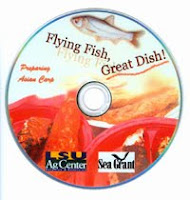June 14th, 2010 by Irene Miles
From the Muskegon Chronicle:
A perfect storm of invasive species in Lake Michigan continues to clarify the water to historic levels and threaten the lake’s forage base from bottom and top, according to new reports from the Great Lakes Environmental Research Laboratory.
Analysis of current and historic data from Lake Michigan shows serious threats to sport fish brought on by quagga mussels, spiny water fleas and other invasive species that continue to thrive, although researchers remain uncertain how that will influence the lake’s future. Read more.
May 21st, 2010 by Irene Miles
From the Milwaukee-Journal Sentinel:
Thursday was a rough day to be a fish in the Little Calumet River south of downtown Chicago.
Dozens of fishery crews took to the murky waters with barrels of fish poison in the latest effort to keep Asian carp from swimming up the heavily plumbed Chicago waterway system and into Lake Michigan.
“We’re going to be able to kill damn near everything in here,” said the U.S. Fish and Wildlife Service deputy regional director Charlie Wooley at the beginning of a five-day, $1.5 million fish eradication program on a two-mile stretch of river.
Federal officials are hoping to confirm what environmental DNA testing has been telling them for the better part of a year: At least a tiny number of the voracious invasive carp have breached an electric barrier about 25 miles downstream from Lake Michigan.
“If there are Asian carp here, we should get confirmation of that this week,” said John Rogner of the Illinois Department of Natural Resources. Read more.
May 20th, 2010 by Irene Miles
In the ongoing effort to prevent the invasive Asian carp from entering Lake Michigan and the rest of the Great Lakes, one solution keeps popping up: “If you can’t beat them, eat them.” For boaters in the Midwest, this is good news.
“These fish taste great,” said Pat Charlebois, Illinois-Indiana Sea Grant (IISG) aquatic invasives specialist, about Asian carp. Chicago Tribune food critic Phil Vettel echoed this sentiment in a recent review. “I could eat this everyday,” Vettel said of the Asian carp dish offered at a local Chicago restaurant.
In the 27-minute video, U.S. Geological Survey fish biologist Duane Chapman tackles the bones in Asian carp fillets, which make them difficult to eat. He shows step-by-step procedures for deboning the fish, as well as how to remove the bones after they are cut and cooked.
Most people are not aware of the high quality of meat in Asian carp, which Chapman refers to as the hamburger of Asia. According to Charlebois, boaters and anglers often associate Asian carp with common carp, a bottom-feeding fish, and are reluctant to catch and eat them. Rather, Asian carp—a collective term for numerous species, such as bighead and silver carp—feed on microscopic plants and animals that live in the water column so they have much higher quality meat.
Anglers who catch and eat Asian carp will be helping to rid the waters of these invasive species, which disrupt ecosystems and harm native fish populations. “We want people to reduce the number of Asian carp in our waters, and thus reduce their impact on the environment,” Charlebois said. “One way to do that is to encourage anglers to eat the fish.”
Although anglers are encouraged to catch and eat the fish downstream of the electric barrier installed in the Chicago Sanitary and Ship Canal, any Asian carp caught in Chicago area waters should be, if possible, frozen in a sealed plastic bag and reported to IISG (847-242-6440), the Illinois Department of Natural Resources (618-435-8138 x123), or the Indiana Department of Natural Resources (317-234-3883).
Knowing whether Asian carp are in those waters will be useful in the ongoing debate about the measures necessary to prevent Asian carp from entering Lake Michigan.
The video, produced by the Louisiana State University AgCenter, can be seen in three parts on YouTube.
May 11th, 2010 by Irene Miles
Robin Goettel, IISG associate director of education, (right) found plenty of interest in Nab the Aquatic Invader! at the Ocean Today Kiosk at the Smithsonian Natural Museum of Natural History on her recent trip to Washington D.C.
Nab the Aquatic Invader! is an educational web site created by IISG, along with Sea Grant programs in New York, Louisiana, Connecticut, and Oregon to provide the latest information about aquatic invasive species through colorful characters and a crime-solving theme. Since its inception, the project has expanded to include species from coastal regions around the country.
The Ocean Today Kiosk, developed by NOAA in partnership with the Smithsonian Institution, presents news, video stories and in this case, interactive pages that highlight some of the most interesting, surprising, and pressing issues facing our ocean today. Through a large touch-screen interface, kiosk visitors are offered a variety of information about ocean life, current science and technology, and recent discoveries. The kiosk also features a ‘current news’ section, presenting users with near real-time data about ocean and weather conditions around the U.S.
The Nab the Aquatic Invader! feature is focused on the suspects–aka the invasive species–in four regions of the country: Atlantic, Pacific, Gulf, and Great Lakes. In each region, visitors can see read interrogation interviews with the 10 Most Wanted AIS and learn their origin, problems they cause, and some control methods used to slow the spread of these species.
April 28th, 2010 by Irene Miles
From Environmental News Network:
Experts send a mixed message to consumers when it comes to eating fish: it’s good for your heart health but beware of the methylmercury. A new way of organizing and ranking the pollutant’s levels in fish and shellfish may help consumers navigate this apparent contradiction, according to the study’s author. Read more.
April 22nd, 2010 by Irene Miles
From the Great Lakes Echo:
Let’s face it—Chicagoans are a little cocky about their water supply. Forget the arctic winters, the ceaseless traffic jams, the political corruption—Chicagoans’ access to clean, fresh water makes them proud to have chosen this particular locale to call home. They get self-righteous when talking with friends in Phoenix or Los Angeles. Who in their right mind would move to a desert, anyway? It’s just impractical.
But a growing number of city officials, urban planners and environmental experts warn of a massive schism between Chicagoans’ perception of water abundance and the reality—a future of water scarcity if they don‘t begin making radical changes in the way we collect, distribute and consume this vital resource. Read more.
April 21st, 2010 by Irene Miles
Illinois-Indiana Sea Grant’s Tracy Colin was named the University of Illinois Student Employee of the Year Runner Up. She has been an assistant for the communication and education components of the program for three years.
“During the time that she has worked in our program, Tracy has worked on a great variety of projects,” said Irene Miles, communication coordinator. “In every task that we assign, she asks intelligent questions to ensure that she will complete the job in a most efficient and effective manner. We are always impressed with Tracy’s attention to detail. She has also demonstrated a professional demeanor in her contact with people outside of our program, whether they be scientists, legislators, agency professionals, or the general public.”
As part of this honor, Colin was awarded a $200 scholarship and a $75 gift card to the University of Illinois Book Store. She will graduate this spring with a major in political science.
April 15th, 2010 by Irene Miles
In most homes, children are kept out of medicine cabinets to protect them from the dangers of chemicals in medications. Illinois-Indiana Sea Grant’s (IISG) latest product, The Medicine Chest, invites high school students to metaphorically open up those doors and investigate what makes those chemicals harmful to people, pets, and the environment when improperly disposed.
“The new curriculum collection gives educators an instructional tool to create an innovative service-learning experience for their students, while tackling an important environmental and human health concern,” said IISG Associate Director for Education Robin Goettel, who, along with Terri Hallesy, IISG education specialist, helped design this resource. “Through involvement in this project, students serve as agents for change, educating their communities about action steps they can take to reduce harm to aquatic ecosystems from improper disposal of unwanted medicines.”
This resource is one of a handful of measures IISG is taking in response to the growing problem of pharmaceuticals ending up in local waterways. For example, a 2008 Associate Press investigation found low levels of pharmaceuticals in the drinking water supplies of 24 major metropolitan areas.
When medicines expire, people often flush them down the toilet, but wastewater treatment plants are not designed to treat these chemicals. In addition to showing up in drinking water, medications can harm fish and aquatic wildlife. On the other hand, disposing of medicines in the trash can risk leakage from poorly-designed landfills.
One way the curriculum seeks to get students involved in their communities is through active involvement with the Prescription Pill and Drug Disposal Program (P2D2)—a multidisciplinary, service-learning approach to the issue of unsafe disposal. “The P2D2 Program was the impetus and serves as the centerpiece for this curriculum collection,” Goettel said.
Created by Pontiac High School ecology teacher Paul Ritter, the program encourages teachers from various subject to involve their students with this issue and provides lesson plans for environmental science, civics, music, art, language arts, and foreign language.
According to Goettel, a wide range of student projects—billboards, eco-poems, songs, collection boxes, artwork, and student presentations—have sparked community interest, understanding, and action. The P2D2 program also encourages and provides tips for building community partnerships, organizing festivals, and planning collection events.
Many of these projects are described in The Medicine Chest, which also provides useful supplemental resources, including science-based research, fact sheets, and classroom activities.
By rallying students for the cause, Goettel hopes to address another problem—prescription drug abuse. According to the Drug Enforcement Agency, nearly one out of ten high school seniors admits to abusing powerful prescription painkillers and 40 percent of teens and an almost equal number of their parents [falsely] think abusing prescription painkillers is safer than abusing ‘street’ drugs.
“Through this multi-faceted, community-based service-learning program, youth will be empowered to take action that will serve as a catalyst to help reduce teenage drug abuse,” Goettel said. “The students have the capability to learn the content and put their knowledge into community action.”
March 26th, 2010 by Irene Miles
Don’t be fooled by the name. Pests, such as insects and weeds, are not the only victims of pesticide application. Humans, especially children, are in danger of exposure to pesticides—linked to numerous diseases and adverse health conditions—from simply playing or walking barefoot on the lawn. These chemicals can also be tracked into homes and settle on carpets and furniture. Furthermore, pesticides pollute our air, water, and soil.
A new brochure, Natural Lawn Care for Homeowners, explains the advantages of natural lawn care and provides homeowners with the information necessary to maintain a healthy, aesthetically-pleasing lawn without the use of chemicals.
This publication provides step-by-step descriptions of the basic measures that help homeowners accomplish this, including soil testing, fertilizing, watering, and mowing. It also includes research-based explanations of how pesticides can be harmful to human and animal health, degrade soil, pollute water, and harm wildlife.
“Natural lawn care is easy and effective,” said Rachel Rosenberg, Safer Pest Control Project executive director. “You can have a healthy lawn simply by changing a few of your lawn care practices—like mowing higher, keeping your grass clippings on the lawn, watering deeply and infrequently and of course, stopping the use of herbicides and insecticides. A healthy and natural lawn will have the capacity to fight drought, disease and insects without the use of pesticides.”



